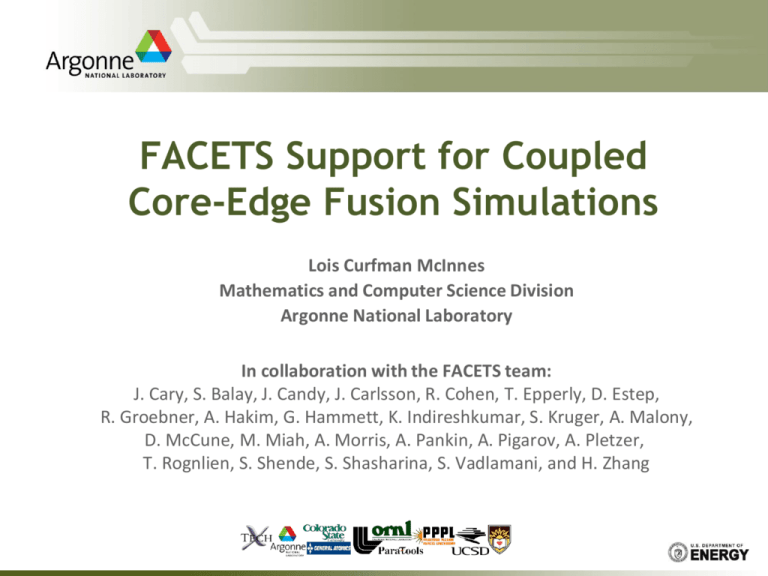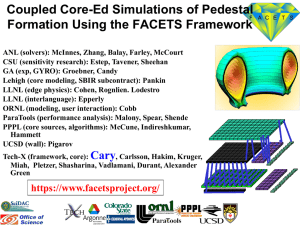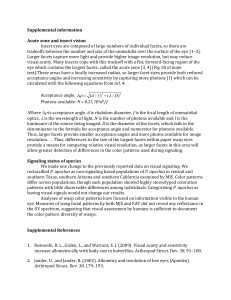SIAM-PP Talk - Applied Mathematics
advertisement

FACETS Support for Coupled
Core-Edge Fusion Simulations
Lois Curfman McInnes
Mathematics and Computer Science Division
Argonne National Laboratory
In collaboration with the FACETS team:
J. Cary, S. Balay, J. Candy, J. Carlsson, R. Cohen, T. Epperly, D. Estep,
R. Groebner, A. Hakim, G. Hammett, K. Indireshkumar, S. Kruger, A. Malony,
D. McCune, M. Miah, A. Morris, A. Pankin, A. Pigarov, A. Pletzer,
T. Rognlien, S. Shende, S. Shasharina, S. Vadlamani, and H. Zhang
Outline
Motivation
FACETS Approach
Core and Edge Components
Core-Edge Coupling
See also MS50, Friday, Feb 26, 10:50-11:15: John Cary:
Addressing Software Complexity in a Multiphysics Parallel
Application: Coupled Core-Edge-Wall Fusion Simulations
L. C. McInnes, SIAM Conference on Parallel Processing for Scientific Computing, Feb 25, 2010
2
Magnetic fusion goal: Achieve fusion power
via the confinement of hot plasmas
Fusion program has long history in
high-performance computing
Different mathematical model
created to handle range of time scales
Recognized need for integration of
models: Fusion Simulation Project,
currently in planning stage
Prototypes of integration efforts
underway (protoFSPs):
– CPES (PI C. S. Chang, Courant)
– FACETS (PI J. Cary, Tech-X)
– SWIM (PI D. Batchelor, ORNL)
ITER: the world's largest tokamak
L. C. McInnes, SIAM Conference on Parallel Processing for Scientific Computing, Feb 25, 2010
3
FACETS goal: Modeling of tokamak plasmas from core
to wall, across turbulence to equilibrium time-scales
How does one contain plasmas from the
material wall to the core, where
temperatures are hotter than the sun?
– What role do neutrals play in fueling the core
plasma?
– How does the core transport affect the edge
transport?
– What sets the conditions for obtaining high
confinement mode?
Modeling of ITER requires simulations on the
order of 100-1000 sec
Fundamental time scales for both core and
edge are much shorter
Acknowledgements
U.S. Department of Energy – Office of Science
Scientific Discovery through Advanced
Computing (SciDAC), www.scidac.gov
Collaboration among researchers in
– FACETS (Framework Application for Core-Edge Transport Simulations)
• https://facets.txcorp.com/facets
– SciDAC math and CS teams
•
•
•
•
TOPS
TASCS
PERI and Paratools
VACET
5
FACETS: Tight coupling framework for
core-edge-wall
Coupling on short time scales
Inter-processor and in-memory
communication
Implicit coupling
Hot central plasma (core): nearly completely
ionized, magnetic lines lie on flux surfaces, 3D
turbulence embedded in 1D transport
Cooler edge plasma: atomic physics important,
magnetic lines terminate on material surfaces, 3D
turbulence embedded in 2D transport
Material walls, embedded hydrogenic species, recycling
FACETS will support simulations with a range
of fidelity
Leverage rich base of code in the fusion community, including
Core:
– Transport fluxes via FMCFM
GLF23 TGLF
GYRO MMM95 NCLASS
– Sources
NUBEAM etc.
Edge:
UEDGE
BOUT++ Kinetic Edge
Wall:
WallPSI etc.
etc.
etc.
FACETS design goals follow from physics
requirements
Incorporate legacy codes
Develop new fusion components when needed
Use conceptually similar codes interchangeably
– No “duct tape”
Incorporate components written in different languages
– C++ framework, components typically Fortran
Work well with the simplest computational models as well as
most computationally intensive models
– Parallelism, flexibility required
Be applicable to implicit coupled-system advance
Take maximal advantage of parallelism by allowing concurrent
execution
Challenge: Concurrent coupling of components
with different parallelizations
Core
– Solver needs transport fluxes for each surface, then nonlinear solve.
Domain decomposition with many processors per cell.
– Transport flux computations are one/surface, each over 500-2000
processors, some spectral decompositions, some domain
decompositions
– Sources are "embarrassingly parallelizable" Monte Carlo computations
over entire physical region
Edge
– Domain decomposed fluid equations
Wall
– Serial, 1D computations
Currently static load balancing among components
– Can specify relative load
– Dynamic load balancing requires flexible physics components
Choice: Hierarchical communication mediation
Core-Edge-Wall
communication is
interfacial
Sub-component
communications
handled
hierarchially
Examples of concurrent
simulation support
Components use
their own internal
parallel
communication
pattern
Edge (e.g.,UEDGE)
Neutral beam sources (NUBEAM)
FACETS Approach: Couple librarified
components within a C++ framework
C++ framework
–
–
–
–
–
Global communicator
Subdivide communicators
On subsets, invoke components
Accumulate results, transfer, reinvoke
Recursive: Components may have subcomponents
Originally standalone, components must fit framework processes
–
–
–
–
–
Initialize
Data access
Update
Dump and restore
Finalize
Complete FACETS interface available via:
https://www.facetsproject.org/wiki/InterfacesAndNamingScheme
Hierarchy permits determination of component
type
FcComponent
FcContainer
FcCoreIfc
FcEdgeIfc
FcWallIfc
FcUpdaterComponent
Concrete implementations of components
FcCoreComponent
FcUedgeComponent
FcWallPsiComponent
Plasma core: Hot, 3D within 1D
Plasma core is the region well inside the
separatrix
Transport along field lines >> perpendicular
transport leading to homogenization in
poloidal direction
1D core equations in conservative form:
– q = {plasma density, electron energy density,
ion energy density}
– F = highly nonlinear fluxes incl. neoclassical
diffusion, electron/ion temperature gradient
induced turbulence, etc., discussed later
– S = particle and heating sources and sinks
q
F S
t
Plasma Edge: Balance between transport
within and across flux surfaces
Edge-plasma region is key for integrated modeling of fusion devices
Edge-pedestal temperature has a large impact on fusion gain
Plasma exhaust can damage walls
Impurities from wall can dilute core fuel and radiate substantial energy
Tritium transport key for safety
Nonlinear PDEs in core and edge components
Core: 1D conservation laws:
thermal energy equations for electrons and ions:
n
p
(ne,iv e,i ) Se,i
, where v e,i & n e,i are electron and ion
t
densities and mean velocities
q
F s
t
where q = {plasma density,
electron energy density,
ion energy density}
Edge: 2D conservation laws: Continuity, momentum, and
v e,i
me,i ne,iv e,i v e,i pe,i qne,i (E v e,i B /c)
t
m
e,i Re,i Se,i
where me,i , pe,i , Te,i are masses, pressures, temperatures
q, E, B are particle charge, electric & mag. fields
m
e,i , Re,i , Se,i
are viscous tensors,
thermal forces, source
3 Te,i 3
2 n t 2 nv e,i Te,i pe,i v e,i qe,i e,i v e,i Qe,i
where qe,i , Qe,i are heat fluxes & volume heating terms
nme,i
F = fluxes, including neoclassical
diffusion, electron and ion
temperature, gradient induced
turbulence, etc.
s = particle and heating sources
and sinks
Challenges: highly nonlinear fluxes
Also neutral gas equation
Challenges: extremely anisotropic transport, extremely strong
nonlinearities, large range of spatial and temporal scales
Dominant computation of each can be expressed as nonlinear PDE: Solve F(u) = 0,
where u represents the fully coupled vector of unknowns
L. C. McInnes, SIAM Conference on Parallel Processing for Scientific Computing, Feb 25, 2010
15
TOPS provides enabling technology to FACETS;
FACETS motivates enhancements to TOPS
TOPS develops, demonstrates, and disseminates
robust, quality engineered, solver software for
high-performance computers
TOPS institutions: ANL, LBNL, LLNL, SNL, Columbia
U, Southern Methodist U, U of California - Berkeley,
U of Colorado - Boulder, U of Texas – Austin
Towards Optimal Petascale Simulations
PI: David Keyes, Columbia Univ.
www.scidac.gov/math/TOPS.html
Applications
Math
TOPS
TOPS focus in FACETS: implicit
nonlinear solvers for base core and
edge codes, also coupled systems
CS
Implicit core solver applies nested iteration
with parallel flux computation
New parallel core code, A. Pletzer (Tech-X)
Extremely nonlinear fluxes lead to stiff
profiles (can be numerically challenging)
– Implicit time stepping for stability
– Coarse-grain solution easier to find; nested
iteration used fine-grain solution
– Flux computation typically very expensive,
but problem dimension relatively small
– Parallelization of flux computation across
“workers” …“manager” solves nonlinear
equations on 1 proc using PETSc/SNES
– Fluxes and sources provided by external
codes
Runtime flexibility in assembly of time
integrator for improved accuracy
Nonlinear
solve
Scalable embedded flux calculations via GYRO
GYRO Ref: J Candy and R Waltz, 2003 JCP, 186 545.
Calculate core ion
fluxes by running
nonlinear
gyrokinetic code
(GYRO) on each flux
surface
For this instance:
64 radial nodes x
512 cores/radial
node = 32,768
cores
Performance
variance due to
topological setting
of the Blue Gene
system used here
(Paratools, Inc.)
UEDGE: 2D plasma/neutral transport code
UEDGE parallel partitioning
UEDGE Highlights
– Developed at LLNL by T. Rognlien et al.
– Multispecies plasma; variables ni,e, u||i,e, Ti,e for
particle density, parallel momentum, and
energy balances
– Reduced Navier-Stokes or Monte Carlo neutrals
– Multi-step ionization and recombination
– Finite volume discretiz.; non-orthogonal mesh
– Steady-state or time dependent
– Collaboration with TOPS on parallel implicit
nonlinear solve via preconditioned matrix-free
Newton-Krylov methods using PETSc
– More robust parallel preconditioning enables inclusion of
neutral gas equation (difficult for highly anisotropic
mesh, not possible in prior parallel UEDGE approach)
– Useful for cross-field drift cases
19
Idealized view: Surfacial couplings between
phase transitions
Core-edge coupling is at location of extreme continuity
(core equations are asymptotic limit of edge equations)
Mathematical model changes but physics is the same
– Core is a 1D transport system with local, only-cross-surface fluxes
– Edge is a collisional, 2D transport system
Edge-wall coupling
– Wall: beginning of a particle trapping matrix
same
points
coupling
w
a
l
l
Core-edge coupling in FACETS
Initial Approach: Explicit flux-field coupling
–
–
–
–
–
Ammar Hakim (Tech-X)
Pass particle and energy fluxes from the core to edge
Edge determines pedestal height (density, temperatures)
Pass flux-surface averages temperature from edge to core
Overlap core-edge mesh by half-cell to get continuity
Quasi-Newton implicit flux-field coupling underway
– Johan Carlsson (Tech-X)
– Initial experiments: achieve faster convergence than explicit schemes
FACETS core-edge coupling inspires new support in PETSc for
strong coupling between models in nonlinear solvers
– Multi-model algebraic system specification
– Multi-model algebraic system solution
L. C. McInnes, SIAM Conference on Parallel Processing for Scientific Computing, Feb 25, 2010
21
Coupled core-edge simulations of H-Mode
buildup in the DIII-D tokamak
Simulations of formation of transport barrier critical to ITER
First physics problem, validated with experimental results, collab w. DIII-D
core
edge
Time history of density over 35 ms
separatrix
Time history of electron temp over 35 ms
Outboard midplane radius
separatrix
L. C. McInnes, SIAM Conference on Parallel Processing for Scientific Computing, Feb 25, 2010
22
Summary
FACETS has developed a framework for tight coupling
–
–
–
–
–
–
Hierarchial construction of components
Run-time flexibility
Emphasis on supporting high performance computing environments
Well-defined component interfaces
Re-using existing fusion components
Lightweight superstructure, minimal infrastructure
Started validation of DIII-D simulations using core-edge
coupling
Work underway in implicit coupling + stability analysis
See also MS50, Friday, Feb 26, 10:50-11:15: John Cary: Addressing Software
Complexity in a Multiphysics Parallel Application: Coupled Core-Edge-Wall
Fusion SImulations
Extra Slides
L. C. McInnes, SIAM Conference on Parallel Processing for Scientific Computing, Feb 25, 2010
24
Core-Edge Workflow in FACETS
Computation
a/g eqdsk
Visualization
fluxgrid input file
fluxgrid
pre file
fragments
pre file
txpp
component
def. files
main
input file
2D geom
file
core2vsh5
“fit” files
profiles
in 2D
matplotlib, VisIt
FACETS
component
output files
main
output file
Black: Fixed form ascii
Green: free-form ascii
Blue: HDF5, VisSchema compliant
Red: Application






